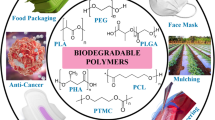Abstract
Methacrylate-terminated 4-arm star-shaped ε-caprolactone oligomer (ME4CLO) was synthesized by reaction of hydroxy-terminated 4-arm star-shaped ε-caprolactone oligomer (H4CLO) having a degree of polymerization per one oligocaprolactone chain, n = 5 and methacryloyl chloride in the presence of triethylamine. The ME4CLO was photo-cured with methacrylate-substituted polysilsesquioxane (ME-PSQ) or mercaptopropyl-substituted polysilsesquioxane (SH-PSQ) at the weight ratios of 16/0, 16/1, 16/2 and 16/4. Fourier transform infrared spectroscopy (FTIR) of the cured hybrid composites revealed addition polymerization of the methacryloyl groups and/or a thiol-ene reaction of methacryloyl and mercapto groups. Transmission electron microscope (TEM) observation revealed phase-separated spherical particles with a diameter of 5 μm for the cured ME4CLO/ME-PSQ 16/2, while the cured ME4CLO/SH-PSQ 16/2 had unstructured, finer-sized particles. DSC analysis revealed crystallization of the oligocaprolactone chain was largely disturbed by the crosslinking reaction and that the cured ME4CLO/ME-PSQ and ME4CLO/SH-PSQ 16/1 showed a higher glass transition temperature than cured ME4CLO. Tensile modulus of cured ME4CLO/ME-PSQ increased with increasing ME-PSQ content while cured ME4CLO/SH-PSQ showed a lower tensile modulus than cured ME4CLO.









Similar content being viewed by others
References
Inoue K (2000) Functional densrimers, hyperbranches and star polymers. Prog Polym Sci 25:453–571
Cameron DJA, Shaver MP (2011) Aliphatic polyester polymer stars: synthesis, properties and applizcations in biomedicine and nanotechnology. Chem Soc Rev 40:1761–1776
Acebo C, Picardi A, Fernández-Francos X, Flor SD, Ramis X, Serra À (2014) Effect of hydroxyl ended and end-capped multiarm star polymers on the curing process and mechanical characteristics of epoxy/anhydride thermosets. Prog Org Coatins 77:1288–1298
Choi J, Kim IK, Kwak SY (2005) Synthesis and characterization of a series of star-branched poly (ε-caprolactone)s with the variation in arm numbers and lengths. Polymer 46:9725–9735
Wang JL, Dong CM (2006) Physical properties, crystallization kinetics, and spherulitic growth of well-defined poly (ε-caprolactone)s with different arms. Polymer 47:3218–3228
Sobczak M, Witkowska E, Olędzka E, Kolodziejski W (2008) Synthesis and structural analysis of polyester prodrugs of norfloxacin. Molecules 13:96–106
Chung I, Xie D, Puckett AD, Mays JW (2003) Synthesis and evaluation of biodegradable multifunctional polymer networks. Eur Polym J 39:1817–1822
Younes HM, Bravo-Grimaldo E, Amsden BG (2004) Synthesis, characterization and vitro degradation of a biodegradable elastomer. Biomaterials 25:5261–5269
Amsden B, Wang S, Wyss U (2004) Synthesis and characterization of thermoset biodegradable elastomers based on star-poly (ε-caprolactone-co-D, L-lactide). Biomacromolecules 5:1399–1404
Uto K, Yamamoto K, Hirase S, Aoyagi T (2006) Temperature-responsive cross-linked poly (ε-caprolactone) membrane that functions near body temperature. J Controlled Release 110:408–413
Serra RSI, Ivirico JLE, Dueñas JMM, Balado AA, Ribelle JLG, Sánchez MS (2009) Segmental dynamics in poly (ε-caprolactone)/poly (L-lactide) copolymer networks. J Polym Sci Part B Polym Phys 47:183–193
Cai L, Wang S (2010) Parabolic dependence of material properties and cell behavior on the composition of polymer networks via simultaneously controlling crosslinking density and crystallinity. Biomaterilas 31:7423–7434
Hakala RA, Korhonen H, Meretoja VV, Seppälä JV (2011) Photo-cross-linked biodegradable polt (ester anhydride) networks prepared from alkenylsuccinic anhydride functionalized poly (ε-caprolactone) precursors. Biomacromolecules 12:2806–2814
Liu Q, Jiang L, Shi R, Zhang L (2012) Synthesis, preparation, in vitro degradation, and application of novel degradable bioelastomers-A review. Prog Polym Sci 37:715–765
Lichtenhan JD, Vu NQ, Carter JA, Gilman JW, Feher FJ (1993) Silsesquioxane-siloxane copolymers from polyhedral silsesquioxanes. Macromolecules 26:2141–2142
Lichtenhan JD, Otonari YA, Carr MJ (1995) Linear hybrid polymer building blocks: Methacrylate-functionalized polyhedral oligomeric silsesquioxane monomers and polymers. Macromolecules 28:8435–8437
Haddad TS, Lichtenhan JD (1995) The incorporation of transition metals into polyhedral oligosilsesquioxane polymers. J Inorg Organomet Polym 5:237–246
Yoon KH, Park JH, Min BG, Polk MB, Schiraldi DA (2005) Properties of poly (ethylene terephthalate) containing epoxy-functionalized polyhedral oligomeric silsesquioxane. Polym Int 254:47–53
Hany R, Hartmann R, Böhlen C, Brandenberger S, Kawada J, Löwe C, Zinn M, Wilholt B, Marchessault RH (2005) Chemical synthesis and characterization of POSS-functionalized poly [3-hydroxyalkanoates]. Polymer 46:5025–5031
Liu Y, Yang X, Zhang W, Zheng S (2006) Star-shaped poly (ε-caprolactone) with polyhedral oligomeric silsesquioxane core. Polymer 47:6814–6825
Sakuma T, Kumagai A, Teramoto N, Shibata M (2008) Thermal and dynamic mechanical properties of organic–inorganic hybrid composites of itaconate-substituted poly (butylene succinate) and methacrylate-substituted polysilsesquioxane. J Appl Polym Sci 107:2159–2164
Ando S, Someya Y, Takahashi T, Shibata M (2010) Thermal and mechanical properties of photo-cured organic–inorganic hybrid composites of terpene-based acrylate resin and methacrylate-substituted polysilsesquioxane. J Appl Polym Sci 115:3326–3331
Shibata M, Obara S (2012) Photo-cured organic–inorganic hybrid composites of acrylated castor oil and methacrylate-substituted polysilsesquioxane. J Appl Polym Sci 126:E12–E20
Fukuda T (2008) Technology of organic–inorganic hybrid material “Compoceran SQ series”. JETI 56:132–137
Schreck KM, Leung D, Bowman N (2011) Hybrid organic/inorganic thiol-ene-based photopolymerized networks. Macromolecules 44:7520–77529
Lin H, Wan X, Jiang XS, Wang QK, Yin J (2011) A nanoimprint lithography hybrid photoresist based on the thiol-ene system. Adv Funct Polym 21:2960–2967
Luo A, Jiang X, Lin H, Yin J (2011) “Thiol-ene” photo-cured hybrid materials based on POSS and renewable vegetable oil. J Mater Chem 21:12753–12760
Li L, Liang R, Li Y, Liu H, Feng S (2013) Hybrid thiol-ene network nanocomposites based on multi (metha)acrylate POSS. J Colloid Interface Sci 406:3038
Wang X, Wang X, Song L, Xing W, Tang G, Hu W, Hu Y (2013) Preparation and thermal stability of UV-cured epoxy-based coatings modified with octamercaptopropyl POSS. Thermochimina Acta 568:130–139
Wang L, Li J, Li L, Zheng S (2013) Organic-inorganic hybrid diblock copolymer composed of poly (ε-caprolactone) and poly (MA POSS): Synthesis and its nanocomposites with epoxy resin. J Polym Sci Part A Polym Chem 51:2079–2090
Nakamura T, Chu X, Shimasaki T, Shibata M (2013) Organogelation behavior and thermal properties of supramolecular polymer network composed of carboxy- and pyridyl-terminated 4-arm star-shaped ε-caprolactone oligomers. J Colloid Interface Sci 404:8–15
Hoyle CE, Lee TY, Roper T (2004) Thiol–enes: Chemistry of the past with promise for the Future. J Polym Sci Part A Polym Chem 49:1540–1573
Author information
Authors and Affiliations
Corresponding author
Rights and permissions
About this article
Cite this article
Ito, M., Shimasaki, T., Teramoto, N. et al. Photo-cured organic–inorganic hybrid composites of methacrylate-terminated 4-arm star-shaped ε-caprolactone oligomer and methacrylate- or thiol-substituted polysilsesquioxane. J Polym Res 21, 507 (2014). https://doi.org/10.1007/s10965-014-0507-3
Received:
Accepted:
Published:
DOI: https://doi.org/10.1007/s10965-014-0507-3




